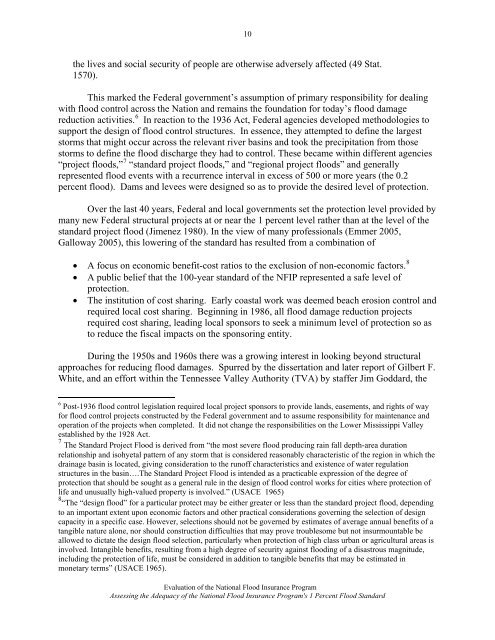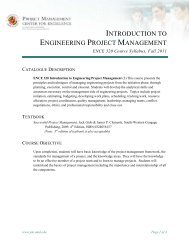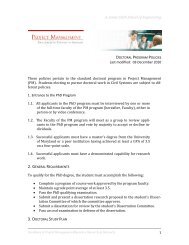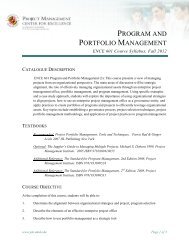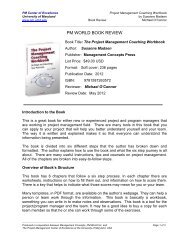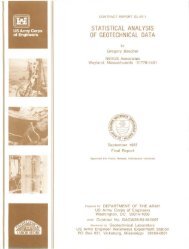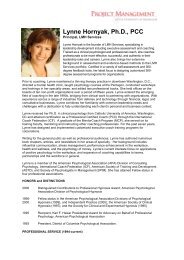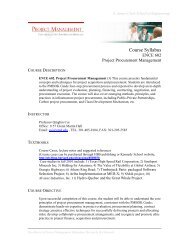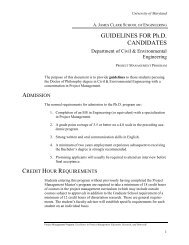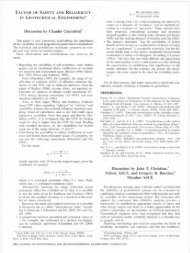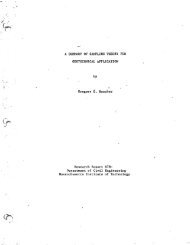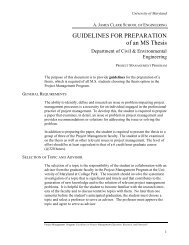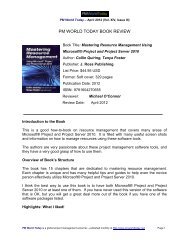Report Outline - Project Management at the University Of Maryland
Report Outline - Project Management at the University Of Maryland
Report Outline - Project Management at the University Of Maryland
Create successful ePaper yourself
Turn your PDF publications into a flip-book with our unique Google optimized e-Paper software.
10<strong>the</strong> lives and social security of people are o<strong>the</strong>rwise adversely affected (49 St<strong>at</strong>.1570).This marked <strong>the</strong> Federal government’s assumption of primary responsibility for dealingwith flood control across <strong>the</strong> N<strong>at</strong>ion and remains <strong>the</strong> found<strong>at</strong>ion for today’s flood damagereduction activities. 6 In reaction to <strong>the</strong> 1936 Act, Federal agencies developed methodologies tosupport <strong>the</strong> design of flood control structures. In essence, <strong>the</strong>y <strong>at</strong>tempted to define <strong>the</strong> largeststorms th<strong>at</strong> might occur across <strong>the</strong> relevant river basins and took <strong>the</strong> precipit<strong>at</strong>ion from thosestorms to define <strong>the</strong> flood discharge <strong>the</strong>y had to control. These became within different agencies“project floods,” 7 “standard project floods,” and “regional project floods” and generallyrepresented flood events with a recurrence interval in excess of 500 or more years (<strong>the</strong> 0.2percent flood). Dams and levees were designed so as to provide <strong>the</strong> desired level of protection.Over <strong>the</strong> last 40 years, Federal and local governments set <strong>the</strong> protection level provided bymany new Federal structural projects <strong>at</strong> or near <strong>the</strong> 1 percent level r<strong>at</strong>her than <strong>at</strong> <strong>the</strong> level of <strong>the</strong>standard project flood (Jimenez 1980). In <strong>the</strong> view of many professionals (Emmer 2005,Galloway 2005), this lowering of <strong>the</strong> standard has resulted from a combin<strong>at</strong>ion of• A focus on economic benefit-cost r<strong>at</strong>ios to <strong>the</strong> exclusion of non-economic factors. 8• A public belief th<strong>at</strong> <strong>the</strong> 100-year standard of <strong>the</strong> NFIP represented a safe level ofprotection.• The institution of cost sharing. Early coastal work was deemed beach erosion control andrequired local cost sharing. Beginning in 1986, all flood damage reduction projectsrequired cost sharing, leading local sponsors to seek a minimum level of protection so asto reduce <strong>the</strong> fiscal impacts on <strong>the</strong> sponsoring entity.During <strong>the</strong> 1950s and 1960s <strong>the</strong>re was a growing interest in looking beyond structuralapproaches for reducing flood damages. Spurred by <strong>the</strong> dissert<strong>at</strong>ion and l<strong>at</strong>er report of Gilbert F.White, and an effort within <strong>the</strong> Tennessee Valley Authority (TVA) by staffer Jim Goddard, <strong>the</strong>6 Post-1936 flood control legisl<strong>at</strong>ion required local project sponsors to provide lands, easements, and rights of wayfor flood control projects constructed by <strong>the</strong> Federal government and to assume responsibility for maintenance andoper<strong>at</strong>ion of <strong>the</strong> projects when completed. It did not change <strong>the</strong> responsibilities on <strong>the</strong> Lower Mississippi Valleyestablished by <strong>the</strong> 1928 Act.7 The Standard <strong>Project</strong> Flood is derived from “<strong>the</strong> most severe flood producing rain fall depth-area dur<strong>at</strong>ionrel<strong>at</strong>ionship and isohyetal p<strong>at</strong>tern of any storm th<strong>at</strong> is considered reasonably characteristic of <strong>the</strong> region in which <strong>the</strong>drainage basin is loc<strong>at</strong>ed, giving consider<strong>at</strong>ion to <strong>the</strong> runoff characteristics and existence of w<strong>at</strong>er regul<strong>at</strong>ionstructures in <strong>the</strong> basin….The Standard <strong>Project</strong> Flood is intended as a practicable expression of <strong>the</strong> degree ofprotection th<strong>at</strong> should be sought as a general rule in <strong>the</strong> design of flood control works for cities where protection oflife and unusually high-valued property is involved.” (USACE 1965)8 “The “design flood” for a particular protect may be ei<strong>the</strong>r gre<strong>at</strong>er or less than <strong>the</strong> standard project flood, dependingto an important extent upon economic factors and o<strong>the</strong>r practical consider<strong>at</strong>ions governing <strong>the</strong> selection of designcapacity in a specific case. However, selections should not be governed by estim<strong>at</strong>es of average annual benefits of <strong>at</strong>angible n<strong>at</strong>ure alone, nor should construction difficulties th<strong>at</strong> may prove troublesome but not insurmountable beallowed to dict<strong>at</strong>e <strong>the</strong> design flood selection, particularly when protection of high class urban or agricultural areas isinvolved. Intangible benefits, resulting from a high degree of security against flooding of a disastrous magnitude,including <strong>the</strong> protection of life, must be considered in addition to tangible benefits th<strong>at</strong> may be estim<strong>at</strong>ed inmonetary terms” (USACE 1965).Evalu<strong>at</strong>ion of <strong>the</strong> N<strong>at</strong>ional Flood Insurance ProgramAssessing <strong>the</strong> Adequacy of <strong>the</strong> N<strong>at</strong>ional Flood Insurance Program's 1 Percent Flood Standard


